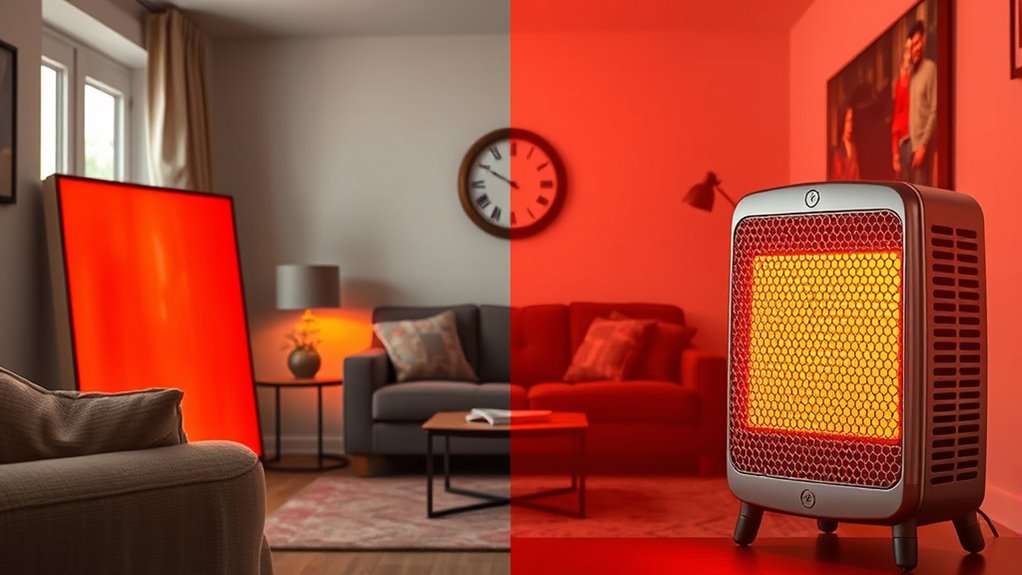Infrared heaters warm your space by directly energizing surfaces and people, offering quick, targeted heat that feels cozy within minutes. Convection heaterswork by warming the air, providing even warmth but needing more time and energy. Infrared units are ideal for outdoor, poorly insulated, or spot heating, while convection models suit small, well-insulated rooms. Understanding how each works helps you choose the best option—continue exploring to find the perfect fit for your needs.
Key Takeaways
- Infrared heaters warm objects and surfaces directly, providing instant heat and quick room temperature increase.
- Convection heaters heat the air gradually, creating a uniform temperature over time through circulating warm air.
- Infrared units do not circulate air or dust, improving indoor air quality and reducing allergens.
- Convection heaters are more effective in well-insulated indoor spaces, maintaining consistent air temperature.
- Infrared heaters are ideal for outdoor or poorly insulated areas, offering targeted warmth and energy efficiency.
How Infrared Heaters Directly Warm Surfaces and People
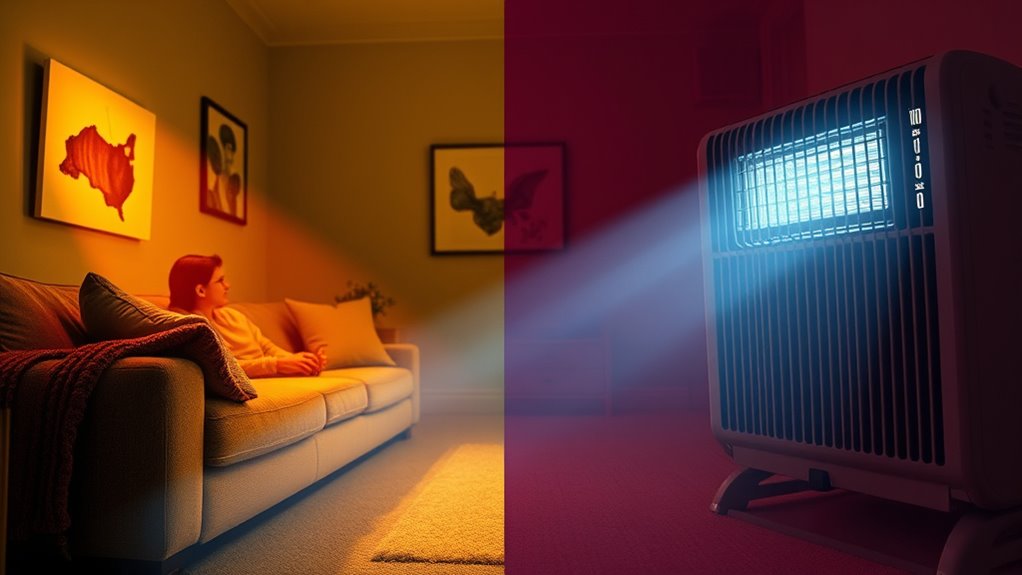
Have you ever wondered how infrared heaters provide almost instant warmth? It’s because they use radiant heat, which directly targets objects and people in their path. Unlike traditional heaters that warm the air first, infrared emits electromagnetic radiation that immediately heats surfaces and skin upon contact. This means you feel the warmth almost instantly, without waiting for the room to heat up. Infrared energy resembles sunlight but without harmful UV rays, making it safe for indoor use and direct skin contact. The radiant heat penetrates surfaces quickly, providing efficient, targeted warmth where you need it most. With infrared heaters, you get a cozy feeling fast, thanks to their direct and immediate transfer of heat through electromagnetic waves. Efficient heat transfer is achieved because of the way infrared energy interacts with objects in its path.
The Process of Heating Air With Convection Devices
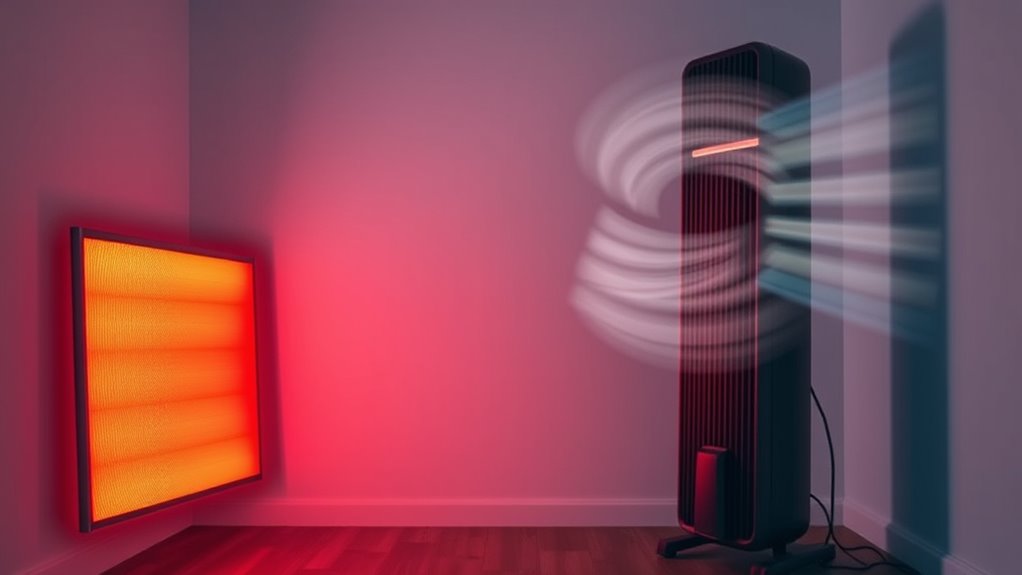
With convection heaters, cool air is drawn in at the bottom, heated internally, and then rises to warm the room. This natural circulation creates a steady cycle that distributes heat evenly without fans. However, understanding how air moves and the challenges of consistent heat distribution helps you optimize their effectiveness. Additionally, home layout and usage patterns can influence the efficiency of heating devices through home layout and usage patterns, indirectly impacting how well a convection heater performs. Proper insulation and airflow dynamics are crucial factors that affect how effectively warm air circulates and maintains a comfortable room temperature. Ensuring material durability in these devices can also enhance their longevity and consistent performance over time. Recognizing system maintenance needs is vital for maintaining optimal operation and avoiding unexpected failures.
Air Heating Mechanics
Convection space heaters warm a room by directly heating the air, which then rises due to its lower density. Inside convection heaters, electrical elements heat the air, causing it to become less dense and ascend. As the warm air rises, cooler air is pushed downward, creating a natural convection current that circulates heat throughout the space. These heaters typically feature vents or grilles to facilitate airflow, helping distribute warmth evenly. This process relies on the principle that warm air rises, gradually increasing room temperature over about 15-20 minutes, depending on insulation and heater size. Proper air circulation can enhance the efficiency of heat distribution, ensuring a more uniform temperature throughout the room. Additionally, the design of innovative planter shapes can optimize air circulation and heat distribution in indoor environments, especially when combined with proper placement and effective insulation. Good airflow management is essential for maximizing heater performance and maintaining consistent comfort levels. Proper ventilation techniques are also crucial for maintaining indoor air quality and efficient heating.
Heat Distribution Challenges
Heating a room with convection devices can present challenges because the process relies on the movement of warm air, which doesn’t always distribute heat evenly. As the air heats, it rises, creating natural convection currents that can leave some areas cooler. Factors like poor insulation or drafts quickly dissipate heat, making uniform warmth difficult. Large or drafty spaces especially struggle, as warm air disperses before reaching every corner. This cycle of cool air entering, warming, and rising takes time to create a consistent temperature.
| Aspect | Effect | Solution |
|---|---|---|
| Air movement | Uneven heat distribution | Use fans or multiple heaters |
| Insulation quality | Heat loss and uneven warmth | Improve insulation |
| Room size | Larger rooms are harder to heat | Add more or larger heaters |
| Drafts | Cool air disrupts circulation | Seal leaks and doors |
| Heating cycle | Slow to achieve uniformity | Use thermostats or infrared heaters |
Speed and Efficiency of Infrared Heating

Infrared heaters warm objects and surfaces almost instantly, so you feel the heat within seconds. This quick response helps you reach your comfort level faster and reduces energy waste. As you increase the temperature, they become even more efficient, saving you money on energy bills. Additionally, their ability to target specific areas makes them a more effective heating option for personalized comfort. Because they directly heat people and objects rather than the surrounding air, infrared heaters are especially suitable for personalized heating needs and immediate warmth. Their rapid heating capability can also contribute to noise levels being minimal, ensuring a quiet environment while effectively warming your space. Properly shifting gears on your heating system can further optimize energy use and comfort.
Rapid Warm-Up Time
Infrared heaters deliver warmth almost instantly because they heat objects and people directly, rather than relying on warming the surrounding air first. This results in a rapid warm-up, making your space feel cozy in minutes. Here’s what makes them so efficient:
- Immediate heat transfer – infrared radiation hits surfaces and skin directly, providing quick comfort.
- Fast temperature rise – rooms can increase by several degrees within just a few minutes.
- Superior efficiency – up to 7.34% temperature increase in half an hour, thanks to direct energy transfer.
- Optimized heating performance – understanding the tuning of heating elements can further enhance efficiency and responsiveness of infrared units.
- Additionally, infrared heaters often require less energy to achieve the same level of comfort compared to traditional convection systems, which contributes to their overall energy efficiency. Proper installation and regular maintenance can further improve their performance and longevity.
- Because infrared heating relies on direct energy transfer, it minimizes heat loss and ensures more consistent warmth.
Energy Consumption Savings
Have you ever noticed how quickly infrared heaters can warm a space compared to traditional models? Because they warm objects directly, infrared heaters transfer heat faster, reducing energy consumption. They often require less operational time, saving up to 30% on energy bills. Infrared systems reach your desired temperature quickly, cutting down on wasted energy during long warm-up periods typical of convection heaters. Unlike convection heaters that cycle air continuously, infrared heaters deliver direct heat only when needed, maintaining efficiency. The exponential relationship between temperature and radiant heat transfer means they become even more efficient at higher temperatures. Overall, infrared heaters use less energy while providing faster, more targeted warmth, making them a smarter choice for saving on energy consumption.
How Convection Heaters Distribute Warm Air Throughout a Space
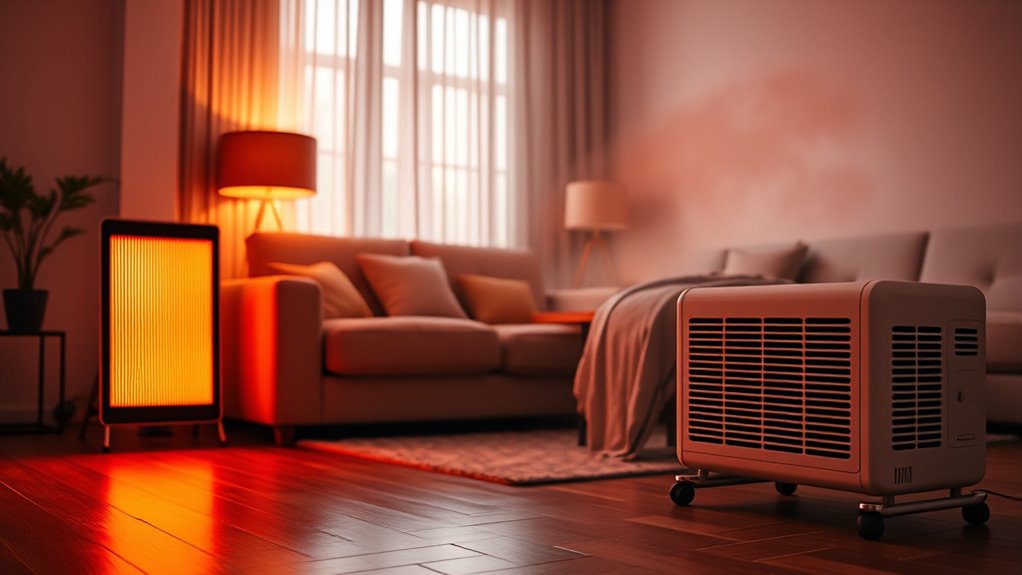
Convection heaters distribute warm air throughout a room by drawing in cool air at the bottom, heating it with a built-in element, and then releasing the warm air back into the space. This process creates a circulation pattern that promotes even heating. Here’s how it works:
Convection heaters warm rooms evenly by circulating heated air through natural airflow patterns.
- Cool air is pulled into the heater and warmed by the element.
- As the warm air rises, it pushes cooler air downward, establishing natural airflow.
- The continuous cycle of cool air being drawn in, heated, and circulated gradually raises the room’s temperature.
- Proper placement and understanding of air circulation can enhance the efficiency of convection heating in different spaces. Recognizing the causes of uneven heating can help optimize heater placement for better comfort.
This circulation guarantees that warm air spreads throughout the space, but its effectiveness depends on factors like insulation, room size, and air movement. Poor circulation can lead to uneven heating.
Energy Consumption and Cost Differences Between the Two Types
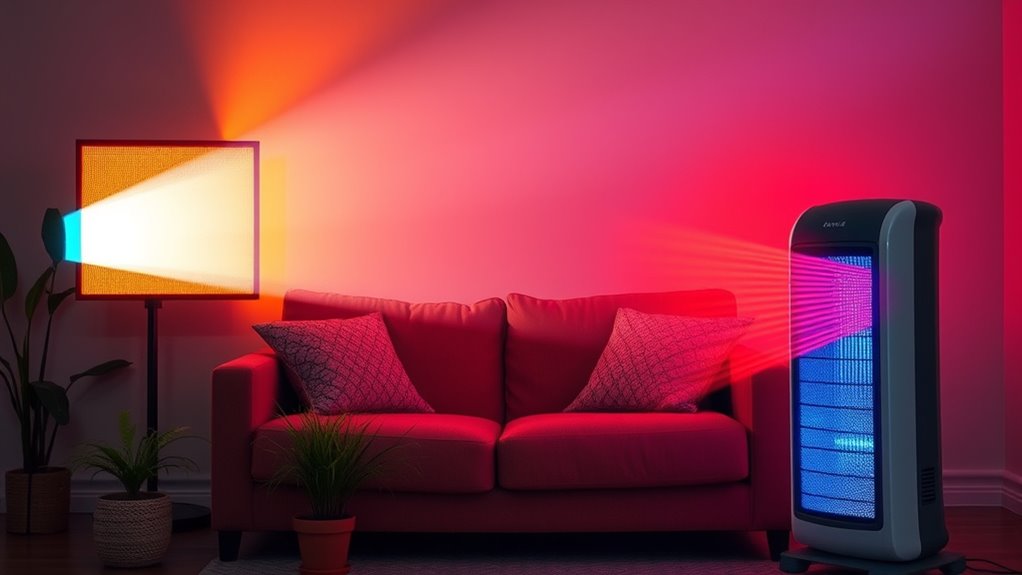
Because infrared heaters directly warm objects and people instead of the surrounding air, they typically use less energy and deliver warmth more quickly. This efficiency makes them more cost-effective, especially for smaller spaces or spot heating. Infrared heaters convert nearly 100% of electrical energy into heat, reducing energy consumption compared to convection heaters, which need longer runtimes and higher wattage to warm the air evenly. Studies show infrared systems can cut energy bills by up to 30%, particularly in poorly insulated areas. In contrast, convection heaters often lose some energy through heat dissipation and require more power, increasing overall costs. Over time, infrared heaters tend to be more economical due to their rapid heating capabilities and lower operational durations, making them a smarter, more cost-effective choice for consistent warmth. Additionally, the efficient energy use of infrared heaters contributes to their growing popularity among environmentally conscious consumers.
Furthermore, their quick heating ability reduces the need for continuous operation, further lowering energy costs.
Impact on Indoor Air Quality and Dust Circulation
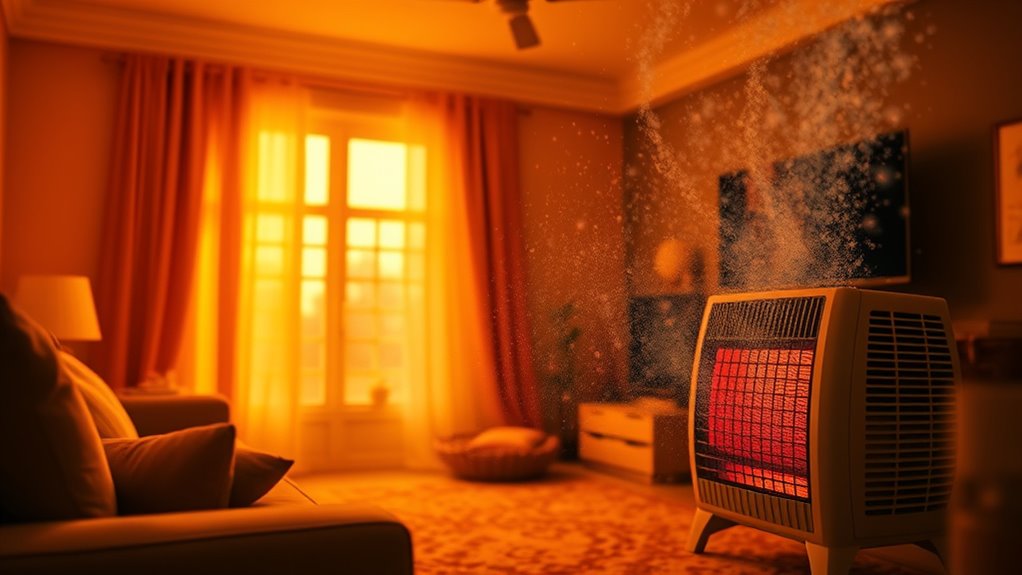
Infrared heaters improve indoor air quality by not circulating air or dust, which helps reduce airborne allergens and pollutants. Unlike convection heaters, they directly target objects and people, minimizing dust circulation and preventing allergens from spreading. This makes them ideal for allergy sufferers or those with respiratory issues. Consider these benefits:
- Reduced dust circulation keeps pollutants and allergens from dispersing throughout your space.
- No airflow means less stirring up of dust and particles, improving overall air quality.
- Less movement of air lowers the risk of aggravating respiratory conditions caused by airborne irritants.
Ideal Environments for Infrared vs. Convection Heating
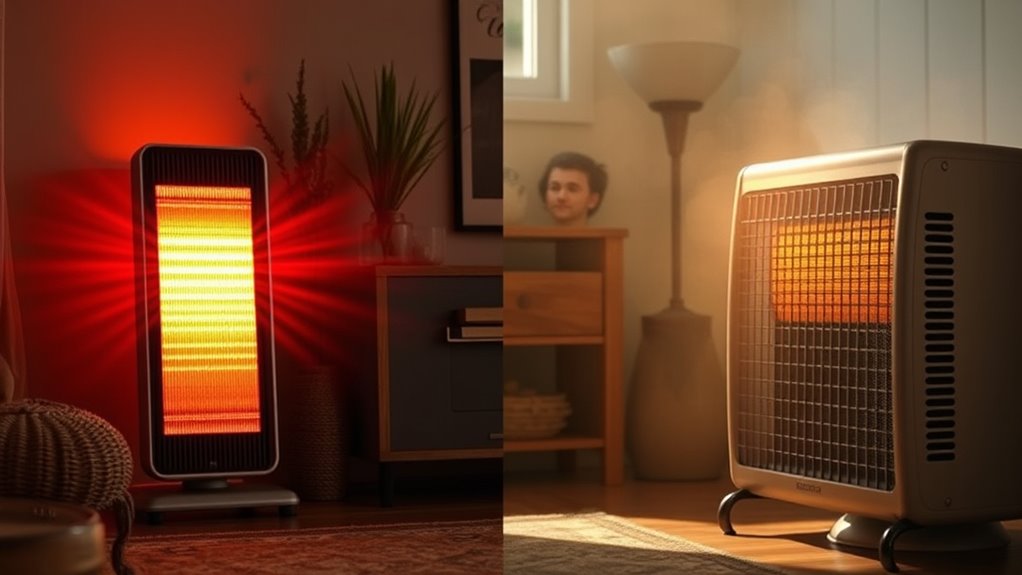
Choosing the right heating method depends largely on your environment and specific needs. Infrared heaters work best in uninsulated or outdoor areas like patios and garages, where direct object heating provides immediate warmth. They’re great for spot heating or quick warm-ups, especially in spaces with high ceilings or drafts. Convection heaters excel in well-insulated indoor environments such as bedrooms and living rooms, where they evenly warm the ambient air for consistent comfort. These heaters are ideal for continuous, long-term heating, maintaining stable temperatures in enclosed spaces. If you need targeted, rapid warmth, infrared is your best choice. For sustained, uniform heating, convection heaters are more effective. Understanding your environment will help you select the most suitable heating method for ideal comfort.
Residual Heat and How Long Each System Maintains Warmth

While infrared and convection heaters both provide warmth during operation, their ability to retain heat after being turned off varies considerably. Infrared heaters energize objects and surfaces, creating residual heat that lasts for hours. Your room’s thermal properties, like wall and furniture materials, influence how long this warmth persists. Conversely, convection heaters warm the air directly, which cools quickly once the heater stops, resulting in minimal residual heat.
Infrared heaters retain heat longer by energizing surfaces; convection heaters cool quickly after use.
- Infrared systems heat thermal mass, releasing stored heat gradually and maintaining warmth longer.
- The residual heat from infrared heaters depends on surface materials’ thermal properties, prolonging comfort.
- Convection heaters produce immediate warmth but lose heat rapidly, offering short-lived comfort.
Understanding these differences helps you choose the right system for sustained warmth.
Safety Considerations for Infrared and Convection Heaters
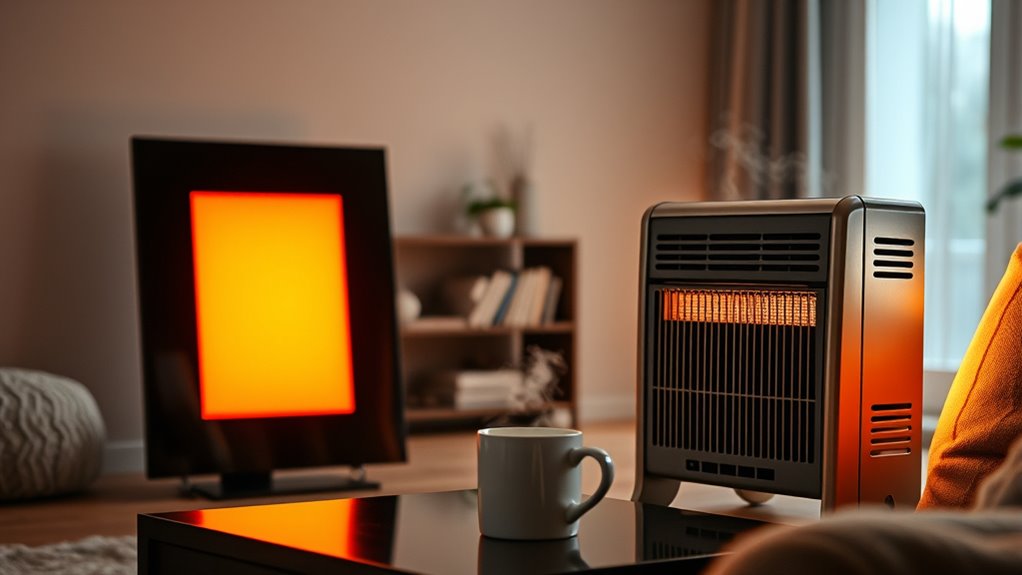
Safety features like tip-over switches, overheat protection, and cool-touch housings are essential when choosing a heater. These mechanisms help prevent accidents and injuries, especially if you have children or pets nearby. Always look for safety certifications from organizations like UL, ETL, or CE to guarantee the heater meets established safety standards.
Overheat Protection Features
Overheat protection is a crucial safety feature found in both infrared and convection heaters that helps prevent potential fire hazards. This safety mechanism automatically turns off the heater when internal temperatures surpass safe levels, typically between 130°C and 150°C. Here are three key points:
- It prevents overheating by shutting down the unit before damage occurs.
- Most models include high-quality wiring coated with silicone or securely soldered to reduce electrical faults.
- Certified heaters often carry safety marks like UL, ETL, or CE, confirming they meet strict safety standards.
These features are essential for safe operation, giving you peace of mind while enjoying efficient warmth. Overheat protection safeguards your home and ensures your heater’s longevity.
Tip-Over Safety Mechanisms
Tip-over safety mechanisms are essential features that automatically shut off infrared and convection heaters if they tip beyond a safe angle, usually around 30 degrees. This tip-over safety prevents fires caused by accidental falls or instability by cutting power when the heater is knocked over. Many models include a red indicator light or alert to inform you when the tip-over switch activates, prompting you to reset or reposition the heater safely. These features often work alongside overheat protection systems, creating a all-encompassing safety net. Proper placement and regular maintenance help prevent accidental tip-overs, ensuring safe operation. Incorporating tip-over safety and overheat protection features helps keep your space warm without compromising safety.
Safe Material Certifications
Choosing a space heater that’s certified by reputable organizations like UL, ETL, or CE can considerably reduce safety concerns. These safety certifications indicate the heater’s materials have passed strict testing for durability and flame resistance, assuring safe operation over time. When evaluating a heater, look for:
- Materials tested for flame resistance, preventing fire hazards.
- Durable components that withstand prolonged use without degrading.
- Certification labels confirming compliance with recognized safety standards.
Certified heaters often include features like cool-touch housings and overheat protection, further minimizing risks. Regularly checking for safety certification labels guarantees you’re selecting a product that meets industry safety requirements. Prioritizing safety certifications for materials helps you avoid potential accidents and keeps your space warmer and safer.
Choosing the Right Heating Method Based on Room Size and Insulation
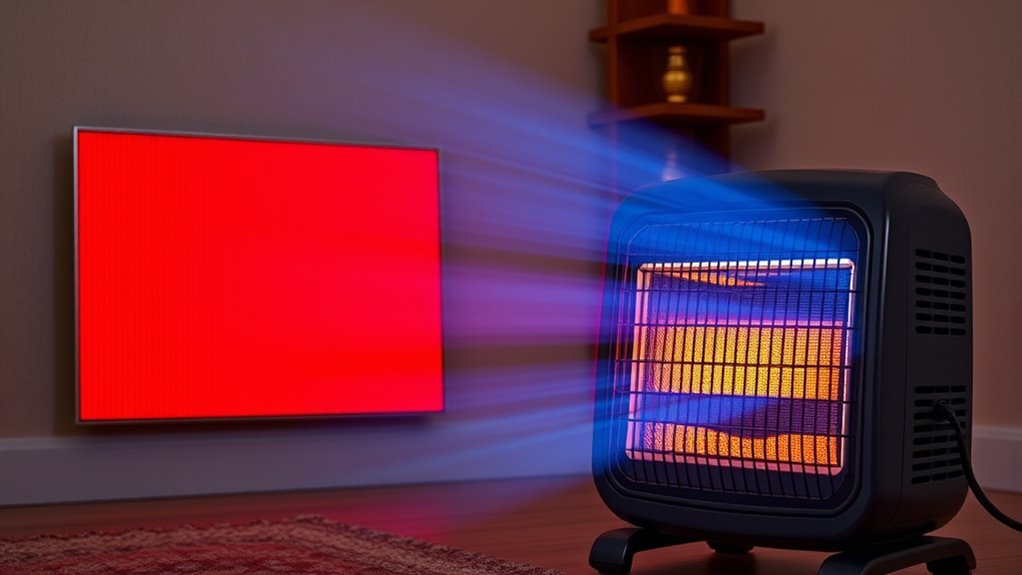
When selecting a heating method, consider your room’s size and insulation quality, as these factors substantially influence efficiency and comfort. For poorly insulated spaces, infrared heaters are highly effective because they directly warm objects and surfaces, reducing heat loss. In large or high-ceilinged rooms, multiple infrared units provide targeted warmth without depending on air circulation. Conversely, in small, well-insulated rooms like bedrooms or offices, convection heaters quickly and evenly raise the temperature, making them ideal. These heaters work best when maintaining a consistent air temperature in enclosed spaces. If your room has good insulation, convection heaters are more energy-efficient, especially for smaller areas. Choosing the right method based on room size and insulation guarantees you stay warm while conserving energy.
Frequently Asked Questions
Do Infrared Heaters Warm up a Room?
Infrared heaters do warm a room, but they do it differently than traditional heaters. Instead of heating the air, you feel warmth directly from objects and surfaces in their line of sight. This makes them great for quick, targeted warmth, especially in small spaces or outdoor areas. However, they might not evenly raise the overall room temperature, especially in larger or poorly insulated rooms.
What Are the Downsides of Infrared Heating?
Think of infrared heating as a spotlight—powerful but focused. Its downsides include higher upfront costs and uneven warmth, especially in large or high-ceilinged spaces. You might find that it doesn’t circulate air well, leading to cold spots. Plus, prolonged exposure at high intensity can cause discomfort or skin dryness. If you’re seeking consistent, whole-room warmth, infrared might not be the best choice, especially for energy efficiency.
What Are the Disadvantages of a Convection Heater?
You should know that convection heaters have some drawbacks. They often struggle to heat large or poorly insulated rooms evenly, leaving cold spots. Since they heat the air, draughty spaces can cause heat loss, making them less efficient. Plus, warm air rises, leading to uneven warmth in rooms with high ceilings. They also take longer to heat up and can stir up dust and allergens, which isn’t ideal if you have allergies.
Which Is Better, Infrared or Space Heaters?
You’re wondering which heater is better, infrared or convection. Infrared heaters can warm objects instantly, with up to 90% efficiency by directly heating people and surfaces, making them ideal for quick, targeted warmth. Convection heaters spread heat evenly, maintaining a consistent room temperature over time. If you need rapid, focused heat, infrared is better; for steady, whole-room warmth, convection wins. Your choice depends on your heating needs.
Conclusion
Choose infrared heaters when you want quick, direct warmth that heats surfaces and people, not just the air. Opt for convection heaters when you need even, widespread heat that circulates throughout the room. Consider your space, your needs, and your budget to make the best choice. Whether you prioritize speed, efficiency, or safety, understanding these differences helps you create a cozy, comfortable environment tailored to your home’s unique demands.
